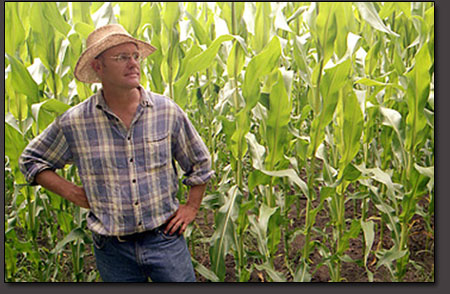| ||
‘The Real Dirt on Farmer John’
by Ari LeVaux John Peterson was a toddler in the 1950s when his mother bought a movie camera. And while she succeeded in documenting the comings and goings on their beloved Illinois farm, she may not have realized that she was also kicking off a five-decade-long project that culminated in the film: “The Real Dirt on Farmer John.” From the opening scenes of John toddling around in his little overalls, his love for the camera is clear. This love developed into skill as John grew into an artist with a gift for storytelling and the patience, eye and wherewithal to create great shots. When he was a teen-ager his dad died, and John took over working his family’s 350-acres of corn, soy, wheat and hay. Then he went to college, eight miles from home, and kept farming. It was the late 1960s, and, via friends he made in college, the late 1960s came over and hung out on his farm. Then came the 1970s. Though John couldn’t have known where all this was going, from an early age he clearly intended to film it. As the events of his life began to circle into a story that looked like it might actually have a happy ending, Farmer John the filmmaker got to work. With the help of a production team lead by Taggart Siegel, this raw footage was spliced with present-day scenes and a few re-enactments into a tight movie that tells a story that hits all the notes, high and low, light, dark and darker. “The Real Dirt on Farmer John” was released in 2007 to wide acclaim, garnering more than 30 national and international film festival awards and Al Gore’s endorsement as “unbelievably special.” After screening in theaters during the summer and fall of 2007, it’s now out on DVD. If your library doesn’t already have it, your librarian might order it. Mine did. Or you can order it for $15 from John’s farm’s website: http://www.angelicorganics.com/. As the film opened, I’ll admit, I was braced for a rehash of the standard foodie rallying cries of the day: the impossible economics of farming, the importance of knowing where your food comes from, local vs. organic, etc. Important stuff, to be sure. Then this crew-cut Scandinavian guy walks across his muddy field, squats down, takes a bite from a handful of mud and chews thoughtfully, and I forgot all about rallying cries and agendas. “The soil tastes good today,” said Farmer John. He is at once an artist trapped in the able body of a failed farmer, and a farmer trapped on a farm he loves, desperately, but can’t hold onto. In addition to his spoken lines, John provides narration in the form of readings from his book, Glitter and Grease. “In the 1970s, spirits ran high, and bankers lent money. Dreams and mistakes and misfortunes could all be financed with loans,” he narrates. “Floods and frosts and droughts, bad seed and low hog prices could all be financed by eager lenders. Debt financed my dreams, then my nightmare. I owed banks, friends and a loan shark hundreds of thousands of dollars.” Particularly striking about this movie is John’s ability to document the scenes of his life in which most people would be too busy feeling sorry for themselves to think of filming. It speaks to the depth of his slavery to art. Here’s John in a depressed stupor after selling off all but 22 acres of his family’s 350-acre farm to pay his debts. There’s John hunched over a coffee cup by the barn, on a cold, brown, windy day as an auctioneer liquidates three generations of farming equipment. From the look on his face, and his narration, you get the impression he’d rather have sold both of his lungs. Farming was his dream and his life, and he had failed. On camera. But when his neighbors turned on him as he tried to make a valiant comeback, things got even worse. “There’s a feeling of theater with farming, a feeling of drama, with weather, people, machinery,” he narrates over a montage of gritty farm-work images. “I love iron. I love steel. I love moving steel around. I love pushing iron through soil … I love using hammers and big wrenches.” He also, it turns out, enjoys driving his tractor while riding sidesaddle in the seat and wearing a scandalously short gold summer dress, his chin held high and wrapped in an orange feather boa. But if you’re thinking this is a movie about John the cross-dressing farmer, you’re wrong. Drama queen, yes – which is why you’ll also see him in a bumblebee costume. “The Real Dirt on Farmer John” is a dramatic story about a dark chapter in the history of middle-America, told by an uninhibited artist who happened to be at ground zero with his camera, his wits and his creative spark. Most importantly, it’s a story that gives a tangible, replicable road map out of the chemical, economic and corporate muck that modern American farming is stuck in. This is a story about story itself, about the place of creativity in a complete person. “The Real Dirt on Farmer John” will probably make you laugh, might make you cry, and if it breaks your heart into little pieces, then it will put them back together again. It’s a story about a deep wound in American history that has only begun to heal, and only in places. John’s farm, we learn, is one of them. •
|


